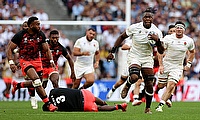World Rugby to limit tackles to waist-height as part of trial
World Rugby has approved a trial for limiting the tackles to waist high as a part of their initiative to reduce concussion-related injuries.
The governing body has planned to introduce the trial in selected domestic tournaments and if proved successful it could come into implementation ahead of the 2023 World Cup. According to the rule, referees will be given power to warn the players over their tackle technique and is seen as a measure to prevent injuries for both the tackler and the tackled player.
Apart from the waist-height tackle, five other major law amendments are also under review.
- The High Tackle Technique Warning which has already been tried in the World Rugby U20 Championship for the last two years and has resulted in 50% reduction of concussion.
- Review of a player's yellow card during his sin-bin period and could be upgraded to red-card if the infringement is on the high-end.
- 50:22 kick: If the team in possession kicks the ball from inside their own half indirectly into touch inside their opponents' 22, or from inside their own 22 into their opponents' half, they will throw in to the resultant lineout.
- World Rugby is also considering to bring a limitation on replacements and a requirement for players to move away from the ball immediately when off their feet at a ruck.
- The awarding of a goal-line drop-out to the defending team when an attacking player, who brings the ball into in-goal, is held up.
"The package of trials will be rolled out as designated closed trials in competitions around the world," World Rugby said in a statement.
"And if successful, would be recommended for global trial within the next Rugby World Cup cycle, meaning Rugby World Cup 2023 could be the first global showpiece to feature law amendments fully aimed at reducing injury risk.
"The core focus of the project is the tackle, which is responsible for 50 per cent of all match injuries and 76 per cent of all concussions (72 per cent occurring to the tackler).
"This is in part driven by an increase of ball in play time by 50 per cent since Rugby World Cup 1987, to approximately 40 minutes today.
"This has given rise to a 252 per cent increase in tackles over the same period, which is why the group is focused on this facet of the game, identifying solutions to reduce the risk of high-risk situations."








